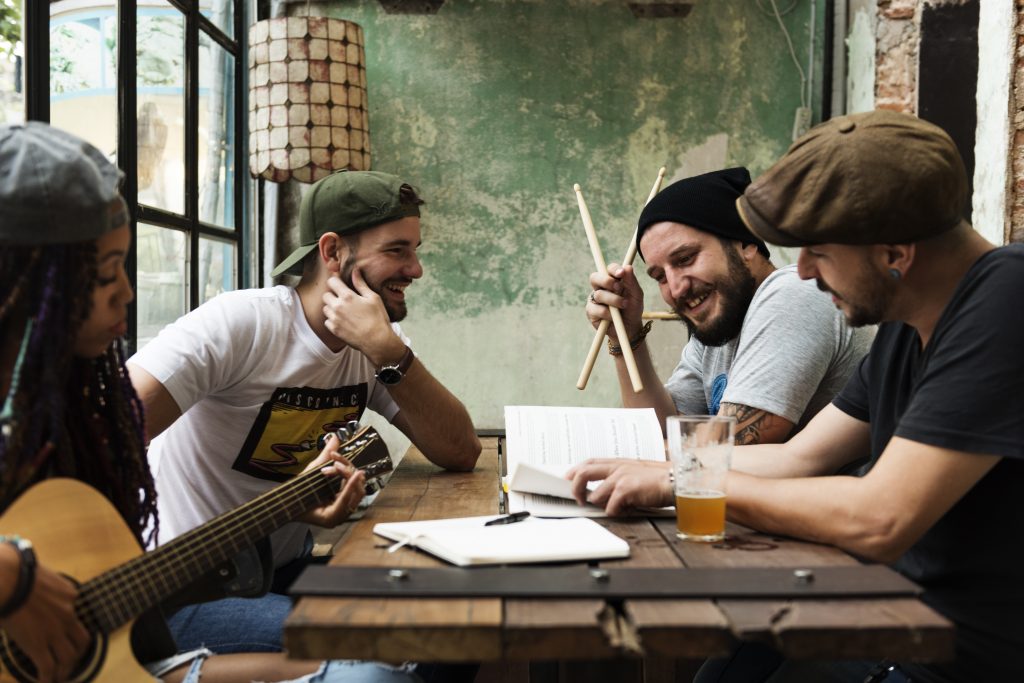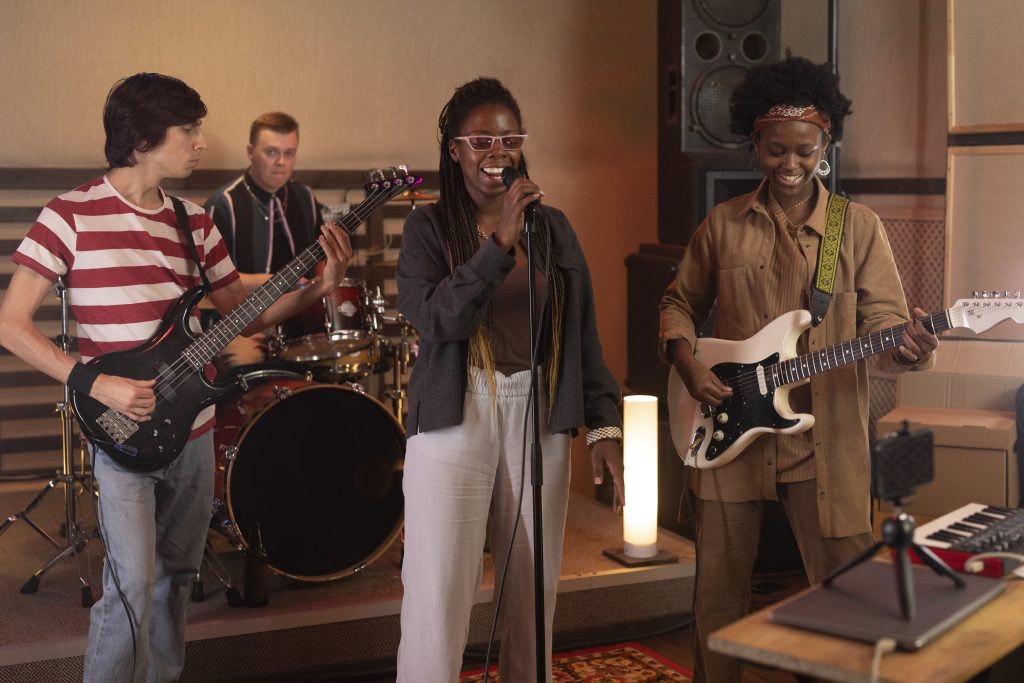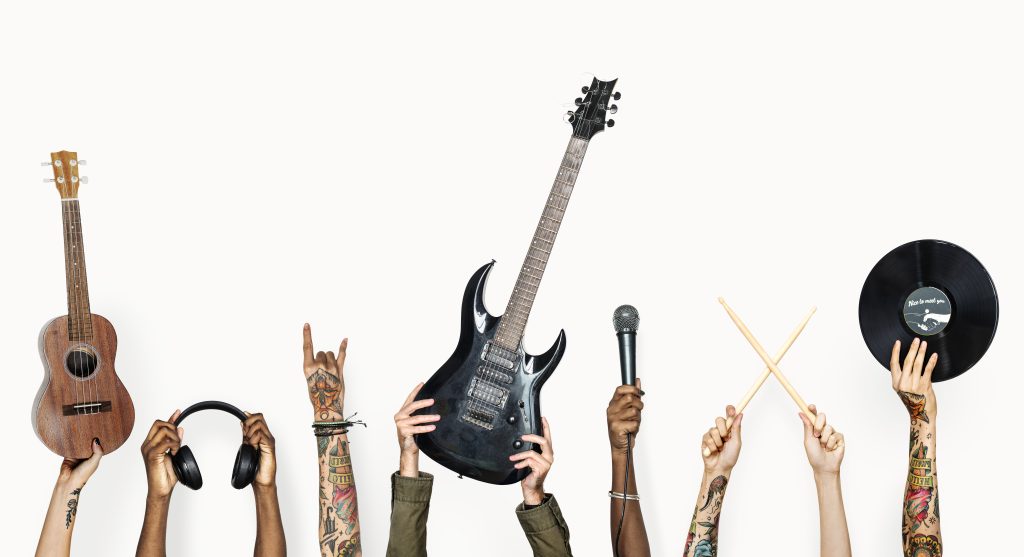
Collaborate, create, and innovate with these simple music collaboration ideas. Start your musical adventure today!
The Key to Creative Growth
Music collaboration can spark creativity and help beginner musicians grow.
When we work together, we combine our ideas and talents, opening up new possibilities and expanding our creative horizons. Music collaboration empowers us to learn, evolve, and create beyond what we can achieve alone.
So, boost your skills, connect with others, and create memorable music.
To start effectively playing with others, you need these essential skills.
Read on for more, ‘Tips on How to Play Guitar with Others’.
Now you’re ready to play!
Beginner-Friendly Music Collaboration Ideas
Entering the world of music collaboration as a beginner is an exciting journey. We’ll explore easy and accessible ways for new guitarists to collaborate with other musicians.
Perfect for beginner guitar players, these tips make music collaboration a breeze.
Music Collaboration No.1: Acoustic Duo
Team up with a singer or another guitarist to form an acoustic duo.
- Find songs with simple open chords in their progressions. If you know barre chords, some songs use just one.
- Start by learning the songs individually, then work on them as a duo. Simplify the arrangement and create your cover versions. This is a great way to develop your guitar skills and develop creativity. Remember that it’s essential to maintain precise timing, fretting technique, and smooth chord transitions.

- If you’re still building confidence, consider playing at family gatherings and special occasions.
- When collaborating with another guitarist, you can do guitar voicings. Beginners can concentrate on rhythm, while more experienced players can explore different guitar voicings.
Music Collaboration No.2: Songwriting Collab
Collaborate with a songwriter to craft original songs, where you, as a guitarist, contribute chord progressions and melodies.

This music collaboration improves your guitar skills and cultivates your songwriting ability, allowing you to create music with others and share it.
Here’s a simple guide for a beginner guitarist looking to collaborate on songwriting:
- Start by connecting with a friend, singer, or songwriter who shares your interest in creating music. Choose someone you feel comfortable with.
- As a guitarist, you can contribute by creating chord progressions. Experiment with different chord combinations to find the right sound.
- Work together to create lyrics that match the mood and theme of the music. This can involve brainstorming ideas, writing verses and choruses, and refining the lyrics.
- Decide on the song’s structure, including verses, choruses, and bridges. Create a clear roadmap for how it will flow.
- Record rough demos of your collaboration using simple recording equipment or smartphone apps. This helps you keep track of your progress and ideas.
- Keep improving your song by tweaking lyrics, melody, or chords as necessary. Practice your parts until they sound polished.
- Share your collaborative song with others, such as friends, family, or fellow musicians, to gather feedback and make improvements.
- Once you’re satisfied with your song, you can perform it live or share it online with your audience.
Music Collaboration No.3: Jamming with Friends
Gather friends who play other instruments and have informal jam sessions.
This is an opportunity to test your abilities. The only preparation you can depend on is consistent practice. This spontaneity helps you assess your progress and ability to perform on the spot.

Jamming with friends as a beginner guitarist is an exciting and valuable experience that can help you improve your skills, have fun, and build a musical connection with others.
Here’s how to get started:
- Find friends who share your passion for music and are willing to jam with you. They can be fellow guitarists, singers, drummers, or other instrumentalists.
- Create a comfortable space where you can play music together. It could be a living room, garage, or any area with enough space for everyone and their instruments.
- Discuss the type of music you want to play. Decide on a genre or style that interests everyone, whether rock, country, folk or something else.
- Choose a comfortable tempo for your jam session. Start slow and gradually increase the speed as you become more comfortable.
- Experiment with simple chord progressions and rhythms.
- Pay attention to what your friends are playing. Listen for cues to change chords, rhythms, or dynamics. Communication is vital during a jam session.
- Don’t be afraid to experiment and improvise. Jamming is about creativity and musical expression. Try different things and see what sounds good.
- Record jam sessions, even with a smartphone. This allows you to listen back, identify areas for improvement, and track your progress.
- Share tips and tricks with your friends, and be open to learning from them. Collaborative learning is a valuable aspect of jamming.
Music Collaboration No.4: Join or Form a Beginner’s Band
Seek out or form a beginner’s band with other novice musicians.
You don’t have to be a pro to form a band. Remember that every great band started somewhere, often with members who were beginners at some point. Don’t let your current skill level discourage you; forming a band is a fantastic way to learn and grow together.

Playing in a band can be fun, but being in a band takes growth further. It adds accountability with shared goals, making you dedicated to your progress and the team’s success.
Here’s a practical guide to starting a band:
- Find musicians who share your interests and goals. Connect with friends, classmates, colleagues, or neighbors to find potential bandmates.
- Decide your band’s goals, whether it’s for fun, local performances, or making original music. Clear goals keep you focused.
- Discuss your musical style and preferences as a group. Decide whether to cover songs, create original music or both. Choose whatever match your skills and interests.
- Start by covering easy songs together and gradually work on original compositions.
- Find a practice space where you can rehearse regularly. It could be someone’s garage, a rented studio, or even a quiet room in one of your homes.
- Establish a practice schedule that works for everyone. Consistent rehearsals are essential for improving your skills and cohesion as a band.
- Pick a name that represents your band’s identity and style.
- Ensure each member has the necessary equipment and gear for their instrument. Invest in quality instruments and sound equipment when your budget allows.
- Make decisions as a group, including song choices, rehearsal schedules, and band goals. Effective communication and compromise are crucial.
- Once you feel confident in your abilities, look for local open mic nights or small venues to showcase your talents. Performing live is a great way to gain experience and exposure.
Forming a beginner’s band is a rewarding experience that allows you to learn, grow, and enjoy the camaraderie of making music with others. Keep practicing, collaborating, and exploring new opportunities to develop your musical journey as a band.
Music Collaboration No.5: Collaborate on Simple Recordings
Live music and recording both offer unique benefits to musicians.
Playing live connects you with the audience and helps you improve your skills, while recordings preserve your music, let you be creative, and explore new ideas.

As it’s recorded, you can track your skill development and spot areas for improvement. Successful musicians balance both to grow and make an impact.
Everything has a first time, so dare to have your first recording session!
Here are the basic steps to get you started:
- Get simple recording gear: microphone, headphones, computer with recording software. Start with a smartphone or a budget-friendly computer.
- Choose a quiet space for clear, distraction-free recordings.
- Place your microphone at an appropriate distance from the sound source (e.g., your voice or instrument). Experiment with microphone placement to achieve the best sound quality.
- If you’re using an external microphone, connect it to your recording device using the appropriate cables or adapters. Make sure your recording device recognizes the microphone.
- Use recording software like Audacity for PC/Mac, GarageBand for Mac, or smartphone voice recording apps.
- Configure your recording software to use your microphone as the input source. Set your recording preferences, including file format (e.g., WAV, MP3), sample rate, and bit depth.
- Perform a test recording and monitor it using headphones. Adjust the microphone placement and recording levels to achieve the desired sound quality.
- Start recording your content. Make sure to capture your performance as intended.
- After recording, use editing software to clean up your audio. You can trim, cut, and arrange recordings as needed. Apply effects like equalization, compression, or reverb to enhance the sound.
- Save your recording in a suitable format and location on your computer or device. Choose a file name that reflects the content and date.
- Depending on your purpose, you can share your recording on social media platforms.
Your recording skills will improve with time and experience, so don’t be discouraged if your first attempts aren’t perfect. Experiment, learn, and enjoy your recording journey!
Musicians Unite
Collaboration involves a shared mission and goal; achieving unity and teamwork is vital. It’s all about building bridges through music.

Music collaboration works best when you’re ready, open to ideas, and share generously.
Therefore,
Be Ready
- Prepare your instruments and materials before each session. Being physically ready ensures a smooth start, allowing you to focus on the creative process.
- Beyond the tangible aspects, come ready with ideas and goals in mind.
Be Open
- Collaboration is a two-way process. Be open to receiving new ideas and feedback from your fellow musicians. This exchange of perspectives can lead to fresh and inspiring results. Listen actively to other inputs; it might spark new directions or improve your initial ideas.
- Be open to trying new musical styles beyond your comfort zone. Collaboration is a chance to experiment and push creative boundaries, leading to fresh and exciting sounds.
- Music connects people. When you collaborate, you build bridges with your fellow musicians and your audience. It can bring people together and create connections.
Be Generous
- Share your ideas openly and be willing to take on responsibilities that contribute to the project’s success.
Music collaboration is not just about skill; it’s about creativity, communication, and shared musical experiences.
Be patient, stay open-minded, and enjoy the journey of making music with others. As you gain experience and confidence, your skills as a guitarist will continue to grow.




